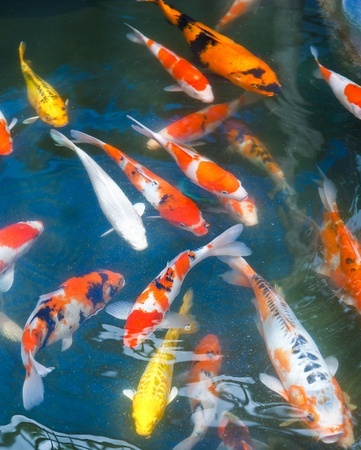Koi Fish Facts
Costia and Koi Fish
This parasite has a fairly intimidating scientific name, going by the handle Ichthyobodo Necatrix in its more common form. It is a silent and deadly microscopic parasite (20 microns) that is highly destructive if not treated early. It is recognizable by its pear shape (pyriform) and two pairs of flagella (one for locomotion and one for feeding). Outbreaks are more likely to occur in early summer.
Ordinarily Costia is not an easy pathogen to diagnose. Accurate diagnosis requires a skin scrape and a microscope. Oftentimes by the time it is accurately identified, a lot of damage will have already happened.
As is the case in more than one of the pathogens that affect koi, Costia can quite frequently be found living on koi in small numbers without harming it. It is only when its numbers grow that the parasite begins to inflict serious damage.

Once the parasite shifts into its parasitic form, it attacks skin and gill tissue with devastating effect. In its implanted phase, Costia burrows into the skin cells. It uses toxins injected through a feeding tube to break down the cells which it then feeds off. Once it begins the process it quickly moves through healthy tissues.
Attacking the gills makes it even more formidable as it hinders the koi’s ability to get oxygen into the body, and so diminishing the koi’s ability to heal. Along with the lesions it creates, this contributes to helping those secondary opportunistic bacterial infections that take advantage of a compromised immune system.
What makes Costia dangerous is the remarkable rate at which it can reproduce. Given the right conditions, it can double its generation size in a few hours. Binary fission (where it simply splits in two), poor water conditions, overstocked ponds and a koi that is already stressed are factors that allow the parasite to flourish.
Fortunately, mature koi fish are less susceptible to Costia, with younger koi more often the ones to die. However, the adult koi are vectors for the parasite and will remain carriers, allowing it to continue to grow. Costia is transferred by contact which means it is easily transferred from one pond or tank to another on nets or socks.
Symptoms
These are some of the symptoms that will accompany Costia:
- Loss of appetite
- Lethargy (long periods of not moving)
- Fin clamping
- Labored (or “heavy”) breathing
- Rubbing
- Red lesions with white slime
- Increased slime production (which appears blue-grey in color)
- Mucous coming out of the gills
The symptoms displayed by koi with Costia aren’t unique to this particular parasite (some can be indicative of poor water conditions), which makes it harder to diagnose. At 20 microns, it can only be accurately identified under a microscope. Even so, it is often still missed.
Lower light (for contrast) and smaller aperture openings with higher magnification (200-400x) is recommended to spot Costia. Additionally, taking samples from both the gills and the skin is a good idea as Costia might show up in one versus the other.
Treatment
Fortunately, Costia is one of the easier protozoa to combat. Ironically, however, the very same mucosal slime coat that protects a koi can do the same for Costia. Once it encysts, the increased mucous production of the slime coat can help to reduce the effectiveness of a chemical treatment like Potassium Permanganate.
Here are some steps to take in combating the spread of the parasite when it is correctly diagnosed:
- A single Potassium Permanganate treatment is generally the first recommended course of action
- However, it should not be used if there is gill damage as it will worsen the already fragile gills
- Also, turn off your UV light if you have one during treatment
- bypass your filter or turn off their pump while potassium is administered, as it will kill the beneficial bacteria in the filter
CAUTION: Overdosing on potassium can be quickly fatal to your fish.
Take extra care when measuring your pond’s volume, and administer the proper dosage.
- Salt treatment (either in a separate bath or as a long-term pond treatment) is a good alternative treatment provided the infection is not severe
- .3% Hydrogen peroxide on the open lesions has been shown to be effective in slowing the Costia infection down
- Single dose of anti-parasite treatments (like malachite green and formalin) are effective, too
So that you don’t have to worry about what could be coming into your pond or tank, at Next Day Koi we put all of our koi fish for sale in separate holding facilities for a 14-day quarantine period, during which time they are closely monitored for any signs of infection or health issues.
To find out how we can get your Living Jewel to you at some of the most competitive shipping costs available, contact one of our representatives.




